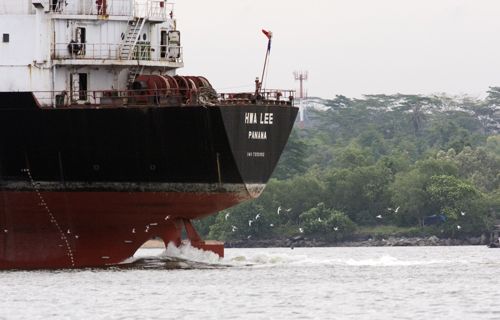“The Black-naped Terns (Sterna sumatrana) that return to Loyang Rock each year have a habit of following passing large ships en masse. When a vessel approaches, a great number (which also includes other species such as Little Terns, Sterna albifrons) would shadow the stern. They appear to be attracted to the ballast water or the wake stirred up by the ship’s passing. Could it be that the movement of the large ship forces up benthic or other marine organisms to the surface, thus giving the terns, which do not dive very deeply, easy pickings? This phenomenon was first observed by Jacqueline Lau from a nearby marina.”
Marcus Ng
The Annotated Budak
21st April 2009










3 Responses
When was a little boy, I asked my uncle who was a sailor for many years, about it.
He explained that the propeller of the ship created turbulence and a lot of bubbles in the water and cause the fish to be disoriented. It is much easier for the seabird to pick up the food.
Hi Marcus,
a boat carrying photographers was berthed right up to the Fairy Point Rock at about 9.15am on the 26 April – the same day of your report above. I saw it all through my binoculars while transiting to Ubin from Changi. I was shocked at how close these fellows went in search of their perfect photos. The boat was snugged tight against the rock! This is not the way for ethical nature photography!
This is not the first time that pohotographers have brought a boat right up against the Fairy Point Rock to take photos of the terns. There seems to be no consideration that the nesting aspect is a sensitive period and that this is the only known nesting site for this tern, within Singapore.
I have even seen a photogrpaher standing on the rock with tripod and camera, while the terns flew around. I set the marine police on him. More protection must be given to this important nesting site.
While most photographers are decent folk who put their subject’s needs above their own, there are still some bad hats out there that are giving everyone a bad name. They need to be weeded out or re-educated!
Some are genuinely ignorant of the impact that they cause while others simply do not care and will not even heed the advise of those more experienced.
This group are responsible for the locally threatened Blue-eared Kingfisher abandoning its nest site at Lower Peirce, recently.
On April 19th, my group and I met a group of Singapore photographers at Panti and were upset to listen to a Banded Kingfisher call being played on a loop tape for at least half an hour! The bird simply did not respond but the prolonged playing could make it abandon its territory there.
I spoke to the photographer to stop the tape as it is simply not working but he chose to continue with an attitude that he knew more than me. We have a 15-minute rule in tape playing and stop after that even if we do not get the bird! Some of us are phasing out tape playing and vocalising instead as it proves less disturbing to the birds on territory. To stop calling at the right time is to concede defeat to the bird as it successfully holds territory by driving away the “rival”.
In the 28 yers that I have actively been in this field, I have seen many birds abandoned their territories around Malaysia and Singapore, as more and more individuals carelessly use tapes. Both bird photographers and birdwatchers have bad hats responsible for this and they must be stopped by those who genuinely care!